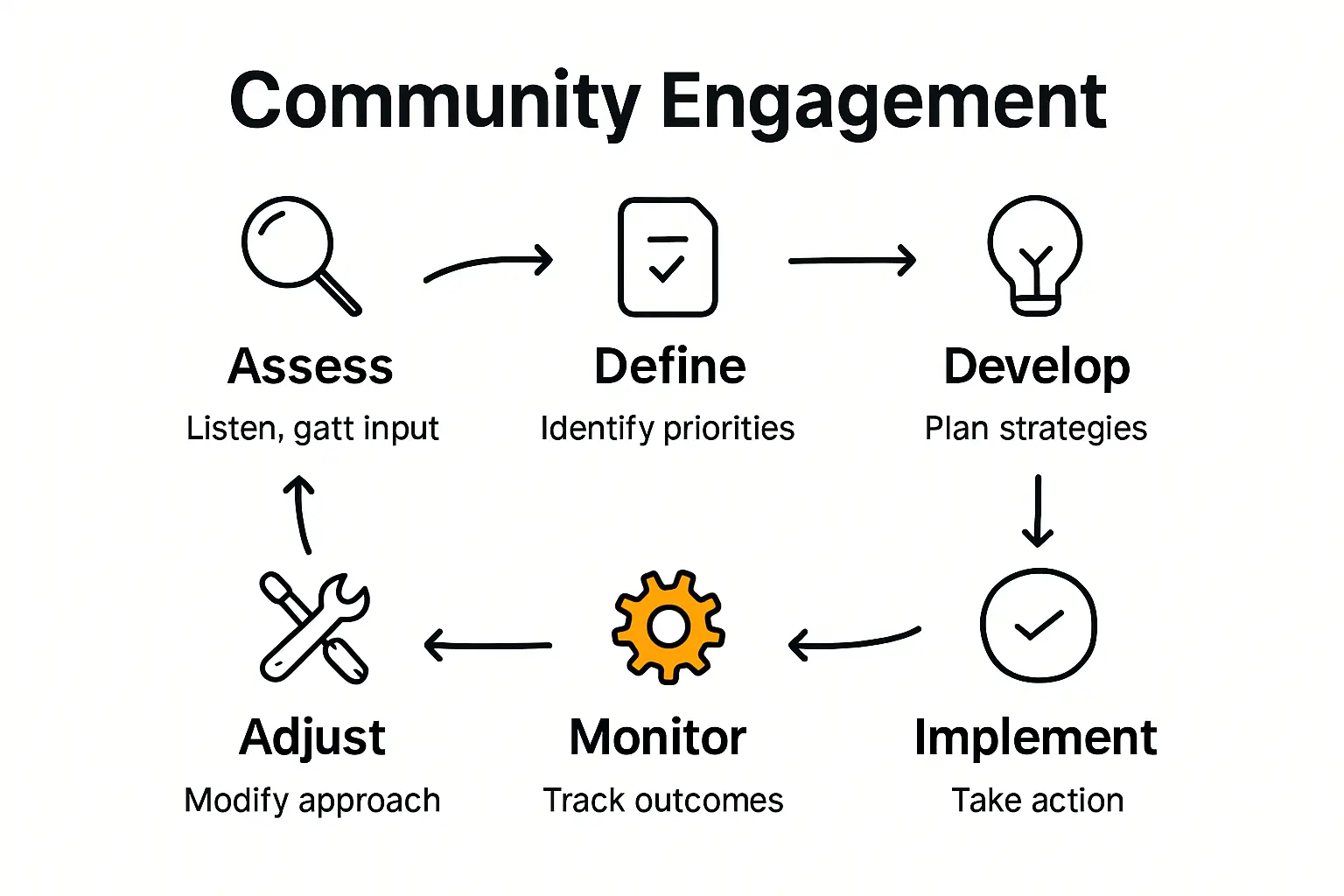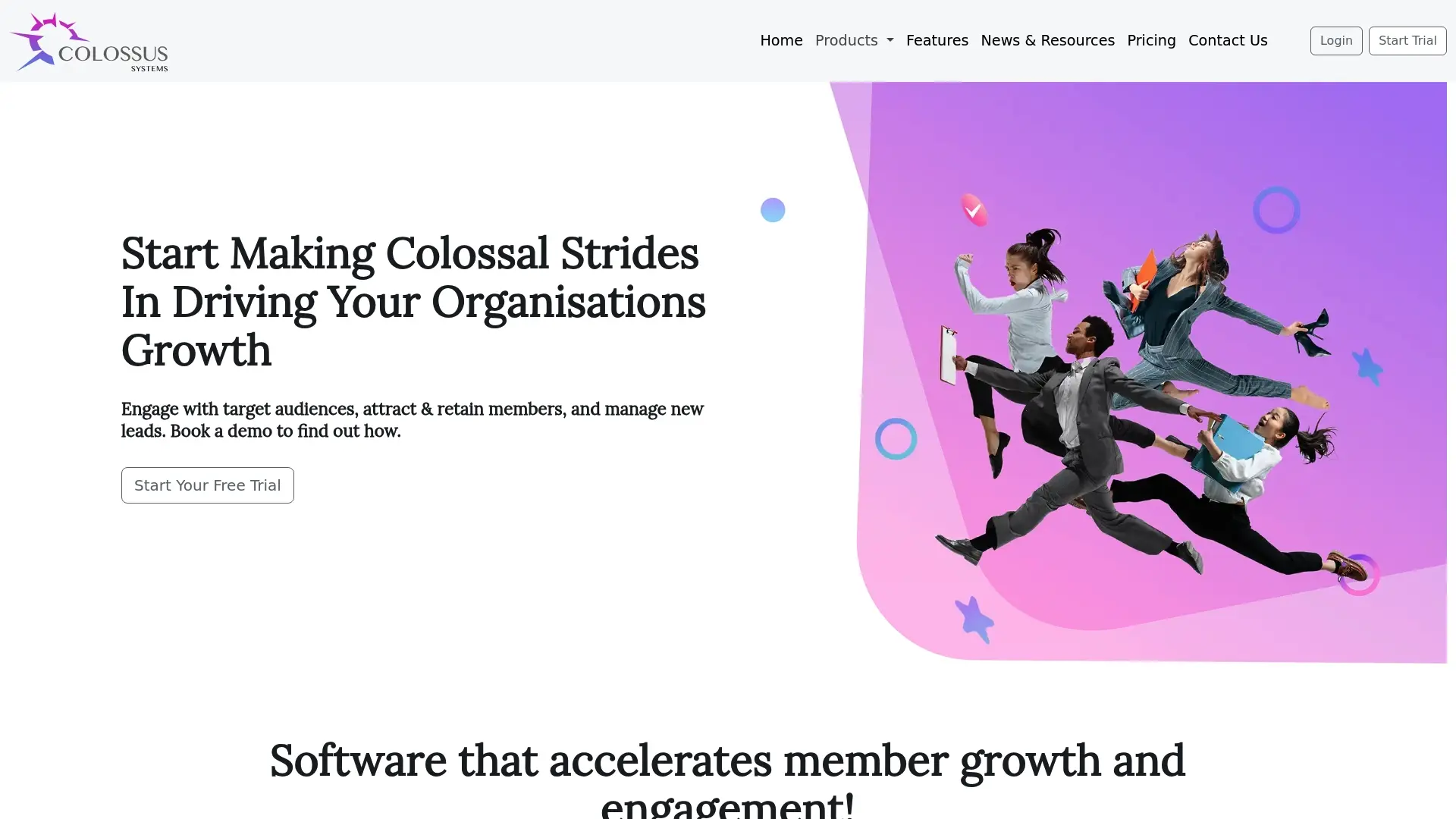Effective Community Engagement Tactics for Lasting Connections
Community engagement can sound straightforward. Most organisations send a few emails, hold an event or two, and think the job is done. Yet, only specific, targeted strategies see member engagement climb by as much as 25 percent within six months. This surprises people who believe all outreach is equal. The real shift starts when you focus on personalisation, real feedback, and agile improvements that actually match your members’ needs.
Table of Contents
- Step 1: Assess Your Current Engagement Strategies
- Step 2: Define Your Target Audience And Goals
- Step 3: Develop Tailored Engagement Tactics
- Step 4: Implement Engagement Activities Consistently
- Step 5: Monitor Participation And Gather Feedback
- Step 6: Adjust Strategies Based On Insights
Quick Summary
| Key Point | Explanation |
|---|---|
| 1. Assess Current Engagement Strategies | Conduct a thorough evaluation of your existing community engagement approaches to identify gaps and opportunities for improvement. |
| 2. Define Target Audience and Goals | Create detailed member personas and establish specific, measurable goals that align with organisational objectives and member expectations. |
| 3. Develop Tailored Engagement Tactics | Formulate personalized communication strategies tailored to the preferences of different member groups for enhanced interaction. |
| 4. Implement Activities Consistently | Maintain a structured yet flexible engagement schedule to ensure continued member connection and support. |
| 5. Monitor Participation and Gather Feedback | Track both quantitative and qualitative engagement metrics, allowing for continuous dialogue and improvement based on member input. |

|
Step 1: Assess Your Current Engagement Strategies
Effective community engagement begins with a comprehensive and honest assessment of your current strategies. This crucial first step helps organisations understand their existing approach, identify gaps, and create a roadmap for meaningful member interactions. The assessment process involves critically examining how your organisation currently connects, communicates, and builds relationships with your community.
To start, gather all existing documentation related to your engagement efforts. This includes membership communication records, event participation data, feedback surveys, and interaction metrics. Look beyond surface level numbers and dig into the qualitative aspects of these interactions. Pay attention to response rates, member satisfaction indicators, and the depth of engagement across different communication channels.
The Minnesota Department of Health recommends conducting a structured evaluation of community connection methods that goes beyond basic metrics. Your assessment should explore several critical dimensions:
- Frequency and quality of member communications
- Diversity and inclusivity of engagement approaches
- Effectiveness of current communication platforms
- Member feedback collection and implementation processes
Next, conduct stakeholder interviews with a cross section of your membership. Speak directly with long term members, newer participants, and those who might have disengaged. These conversations will provide nuanced insights into what works, what doesn’t, and where opportunities for improvement exist. Consider creating anonymous feedback mechanisms to encourage honest, candid responses.
Data analysis is key to this assessment. Map out your current engagement touchpoints and categorise them by effectiveness. Identify patterns of high engagement and areas of potential member dropout. Look for correlation between specific communication strategies and member retention or participation rates.
To provide additional context and depth to your assessment, explore our guide on digital communication strategies which can help you refine your approach. The goal of this initial step is not just to collect information, but to develop a clear, actionable understanding of your current community engagement landscape that will inform future strategic decisions.
Step 2: Define Your Target Audience and Goals
Defining your target audience and goals is a strategic cornerstone of successful community engagement. This step transforms your broad organisational vision into precise, actionable objectives that resonate with specific member segments. The key is moving from generic outreach to targeted, meaningful connection.
Begin by creating detailed member personas that go beyond basic demographic information. Consider not just age and profession, but deeper characteristics like professional aspirations, communication preferences, and potential challenges they face within their professional ecosystem. Develop comprehensive profiles that capture the nuanced motivations and needs of different member groups.
According to research from community engagement experts, effective segmentation involves understanding your audience’s unique characteristics and communication pathways. Map out the different subgroups within your membership, recognising that a one size fits all approach rarely generates meaningful engagement.
Establish clear, measurable goals that align with both organisational objectives and member expectations. Your goals should be specific, quantifiable, and time bound. For instance, instead of a vague goal like “increase member participation,” create a precise target such as “increase active member engagement by 25% within six months through targeted digital communication and interactive virtual events.”
Consider creating goals across multiple dimensions:
- Member retention and growth
- Community interaction levels
- Learning and development participation
- Feedback and satisfaction metrics
Utilise data gathering tools and surveys to validate your audience understanding. Conduct periodic check ins with member representatives to ensure your personas remain accurate and relevant. Learn more about designing strategic engagement approaches that can help refine your targeting strategy.
Verify the success of this step by ensuring you have comprehensive audience personas, clearly defined engagement goals, and a preliminary strategy for reaching each identified member segment. The output should be a living document that provides a clear roadmap for your community engagement efforts, adaptable to evolving member needs and organisational priorities.
Step 3: Develop Tailored Engagement Tactics
Developing tailored engagement tactics transforms your strategic vision into actionable member experiences. This critical step bridges the gap between understanding your audience and creating meaningful interactions that resonate with different member segments. Personalisation is the cornerstone of effective community engagement.
Start by mapping out communication channels that align with each member persona’s preferences. Different groups will respond differently to various platforms. Younger professionals might prefer interactive digital experiences, while seasoned members might appreciate more traditional communication methods. Consider creating a multi channel approach that allows flexibility and choice.
According to research on community engagement, strategic communication approaches should focus on responsiveness and collaborative knowledge creation. Design engagement tactics that invite two way dialogue rather than one directional broadcasting. This might include interactive webinars, personalised email campaigns, discussion forums, or targeted virtual networking events.
Segmentation is key to creating impactful engagement strategies. Develop unique communication pathways for different member groups. For instance, new members might need orientation resources, while long standing members could receive advanced professional development content. Create content and interaction models that evolve with a member’s journey within your organisation.
Consider implementing engagement tactics across multiple dimensions:
- Professional skill development resources
- Networking and collaboration opportunities
- Personalised communication streams
- Recognition and membership milestone celebrations
Utilise technology and data analytics to track engagement effectiveness. Monitor metrics like interaction rates, content consumption, and member feedback to continuously refine your approach. Explore our comprehensive guide on communication strategies to enhance your engagement framework.
Verify the success of this step by ensuring you have developed a comprehensive, flexible engagement strategy that addresses the diverse needs of your member segments. The outcome should be a dynamic playbook of tailored tactics that can be adjusted based on ongoing member feedback and organisational goals.
Step 4: Implement Engagement Activities Consistently
Consistent implementation transforms engagement strategies from theoretical plans into living, breathing community experiences. This step is about creating a predictable yet dynamic rhythm of interaction that keeps members connected and invested. The key is developing a structured approach that feels organic and responsive to member needs.
Begin by creating a comprehensive engagement calendar that maps out activities across different member segments. This calendar should include a mix of digital and in person interactions, ensuring variety while maintaining a reliable communication cadence. Schedule regular touchpoints like monthly webinars, quarterly networking events, and periodic surveys that allow members to feel continuously supported and heard.
According to community engagement research, strategic communication requires sustained commitment to building trust and maintaining relationships. Develop a communication protocol that ensures no member segment feels overlooked. This might involve rotating focus between different member groups, creating targeted content streams, and establishing clear response timelines for member inquiries.
Technology can be a powerful ally in maintaining consistent engagement. Implement automated communication tools that personalise interactions while ensuring regular contact. Use customer relationship management systems to track member interactions, preferences, and engagement levels. These tools help create a seamless experience that feels both systematic and individualised.
Consider implementing engagement activities across multiple platforms:
- Virtual learning sessions
- Interactive online forums
- Personalised email communication streams
- Regular feedback collection mechanisms
Explore our comprehensive guide on membership engagement strategies to refine your approach. Remember that consistency does not mean rigidity. Build flexibility into your engagement framework, allowing room for spontaneous interactions and rapid response to emerging member needs.
Verify the success of this step by establishing clear metrics. Track member participation rates, interaction depth, and feedback quality. The goal is to create an engagement ecosystem that feels both predictable and exciting, where members consistently find value and look forward to each interaction with your organisation.
Step 5: Monitor Participation and Gather Feedback
Monitoring participation and gathering feedback is the critical diagnostic process that transforms raw engagement data into actionable insights. This step is about understanding not just how many members interact, but how deeply and meaningfully they engage with your organisation. Think of it as taking the pulse of your community, identifying strengths, and uncovering opportunities for improvement.
Implement a multi dimensional tracking system that captures both quantitative and qualitative engagement metrics. Use analytics tools to measure participation rates across different activities, tracking metrics like event attendance, content interaction, forum contributions, and response rates to communications. These numbers provide a numerical snapshot of member involvement, but they tell only part of the story.
According to community engagement research, effective feedback mechanisms are crucial for sustained participation. Design multiple feedback channels that cater to different member preferences. Some members might prefer anonymous online surveys, while others might appreciate direct interviews or focus group discussions. The key is creating an environment where members feel genuinely heard and valued.
Technology can significantly enhance your feedback collection process. Utilise digital platforms that allow real time feedback, sentiment analysis, and comprehensive data collection. Implement features like pulse surveys, interactive polls during webinars, and quick feedback buttons that make sharing opinions effortless for members. These tools transform feedback from a periodic activity into a continuous dialogue.
Consider implementing feedback collection through various methods:
- Anonymous online surveys
- Periodic member satisfaction interviews
- Interactive digital feedback platforms
- Suggestion box mechanisms
Explore our comprehensive guide on improving member satisfaction to refine your approach. Remember that gathering feedback is not just about collecting data, but demonstrating that you are committed to continuous improvement and member experience.
Verify the success of this step by establishing a clear feedback analysis framework. Look for patterns in member responses, track changes in engagement levels over time, and create a systematic process for translating insights into actionable strategy adjustments. The ultimate goal is creating a responsive, member centric community that evolves based on genuine member input.
Step 6: Adjust Strategies Based on Insights
Adjusting strategies based on insights is the evolutionary engine of effective community engagement. This step transforms collected data and feedback into meaningful organisational transformation. Think of it as fine tuning an instrument, where each adjustment brings you closer to creating a harmonious member experience that resonates with your community’s changing needs.
Begin by conducting a comprehensive analysis of the feedback and participation data collected in previous steps. Look beyond surface level numbers to understand the underlying narratives and emotional currents within your member community. Identify patterns of engagement, recurring themes in feedback, and potential friction points that might be preventing deeper member involvement.
According to community engagement research, continuous strategy refinement is crucial for maintaining relevance. Create a structured approach to strategy adjustment that involves cross functional teams. Bring together members from different departments to interpret insights, ensuring a holistic view that goes beyond siloed perspectives. This collaborative approach ensures that strategy adjustments are comprehensive and well rounded.
Develop an agile adjustment framework that allows for both incremental and significant changes. Some insights might require minor tweaks to communication styles, while others could necessitate fundamental shifts in engagement approaches. Establish clear decision making criteria that help you differentiate between surface level adjustments and more substantial strategic pivots.
Consider implementing strategy adjustment mechanisms such as:
- Quarterly strategy review sessions
- Rapid prototyping of new engagement approaches
- Pilot programs to test potential changes
- Transparent communication about organisational learning
Learn more about implementing effective organizational changes to support your strategy refinement process. Remember that strategy adjustment is not about radical overhauls, but consistent, thoughtful evolution that keeps your community engagement dynamic and responsive.
Verify the success of this step by establishing clear metrics for strategy adjustment effectiveness. Track how changes impact member participation, satisfaction levels, and overall community sentiment. The ultimate goal is creating a living, breathing engagement strategy that grows and adapts alongside your organisation and its members.
To help ensure all verification steps are met after each stage of the engagement framework, use the checklist below as an actionable reference for completion criteria.
| Step | Completion Checklist |
|---|---|
| Assess Current Engagement | All relevant documentation reviewed; engagement touchpoints mapped; gaps identified |
| Define Target Audience & Goals | Member personas created; objectives quantified; goal alignment confirmed |
| Develop Tailored Tactics | Segment-specific tactics documented; communication preferences mapped |
| Implement Activities Consistently | Engagement calendar published; initial activities executed |
| Monitor Participation & Feedback | Feedback channels activated; engagement metrics collected |
| Adjust Strategies Based on Insights | Strategy review conducted; action plans updated |

Transform Engagement Tactics into Lasting Member Connections
Struggling to turn engagement strategy into real, lasting connections? The article highlights how membership organisations often face obstacles like unclear audience targeting, disconnected communication, and difficulty gathering actionable feedback. These challenges can leave you feeling stuck and unable to move from basic interaction to meaningful, ongoing engagement. The good news is that every assessment, goal, and activity outlined here can come alive with the right digital framework. Imagine your next event, feedback campaign, or personalised email journey resonating with every member—driven by data and delivered at the right moment.

Turn these insights into action today. Colossus Systems provides an all-in-one platform designed for organisations that want to elevate engagement, empower member journeys and grow efficiently. Explore how our powerful CRM and member management tools make tracking participation, event planning and communication seamless and intuitive. Ready to build a truly connected community? Visit https://colossus.systems now to schedule your personalised demo—see how fast you can transform your engagement journey while maximising value for every member.
Frequently Asked Questions
What are the key steps for effective community engagement?
Effective community engagement involves several key steps: assessing current engagement strategies, defining your target audience and goals, developing tailored engagement tactics, implementing activities consistently, monitoring participation and gathering feedback, and adjusting strategies based on insights.
The following table provides an overview of each main step in the community engagement process, summarising the core objective and verification criteria for successful completion.
| Step | Core Objective | Verification Criteria |
|---|---|---|
| 1. Assess Current Engagement | Evaluate existing strategies and identify gaps | Clear understanding of current landscape and opportunities |
| 2. Define Target Audience & Goals | Develop detailed member personas and set objectives | Comprehensive personas and measurable goals established |
| 3. Develop Tailored Tactics | Formulate personalised engagement strategies | Flexible plan of tactics addressing all segments |
| 4. Implement Activities Consistently | Execute scheduled engagement activities across channels | Structured engagement calendar and regular activities |
| 5. Monitor Participation & Feedback | Track participation and gather member input | Multi-channel feedback system and participation data |
| 6. Adjust Strategies Based on Insights | Refine approaches based on analysis | Measured improvements and agile strategy updates |
How can I assess my current community engagement strategies?
Begin by gathering existing documentation related to your engagement efforts, such as communication records, event participation data, and feedback surveys. Conduct stakeholder interviews and analyze interaction metrics to identify patterns of high engagement and areas for improvement.
What should be included when defining my target audience?
When defining your target audience, create detailed member personas that encompass not just demographics but also characteristics such as professional aspirations, communication preferences, and challenges they face. This understanding will guide targeted engagement efforts.
How can I collect feedback effectively from my community members?
Utilise multiple feedback channels to cater to different member preferences, such as anonymous online surveys, interviews, and interactive digital feedback platforms. Ensure that the process is straightforward and encourages genuine responses from members.
Recommended
- Event Marketing Ideas for Membership Groups | Colossus Systems
- Event Marketing Strategies for Membership Groups and Associations|CS
- Understanding Online Community Management: Key Concepts Explained|CS
- Improving Member Engagement: Proven Strategies for 2025|CS
- Skipso
- How to Grow Podcast Audience: Tips for Listeners and Brands | Prodcast